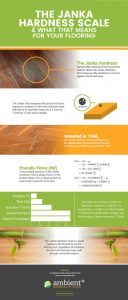Named after Austrian wood researcher Gabriel Janka, the Janka Hardness Scale is utilized to determine an exotic or domestic species’ relative hardness. This test measures the amount of force required to embed a 0.444″ steel ball into the wood piece to half of its diameter. Wooden materials that have a higher Janka rating are harder than woods with a lower Janka rating.
Essentially, this test measures the resistance of wood against dents and wear and determines its overall hardness compared to other wooden materials. For testing, a 6-inch wooden sample is required that is 2-inches wide by 2-inches thick.
One of the most common uses for the Janka hardness test is determining whether or not a wooden species is suitable for use as flooring. A few additional factors affect how flooring performs on the test, including the type of core for engineered flooring such as HDF, oak, pine, birch, poplar; grain direction; floor wear surface; and thickness.
This innovative hardness test was developed over 100 years ago, in 1906. In the late 1920s, the test would be officially standardized by the American Society for Testing and Materials (ASTM).
Force is the resulting measure of the Janka Hardness Test and — in the United States — is represented by pounds-force (lbf).
1 lbf:
= 1lb X Gn
= 1lb X 9.80665 m/S2 / 0.3046 m/ft
= 1lb X 32.174049 ft/Sq
= 32.174049 ft-lb/S2
Red Oak is currently the industry mean for hardness, meaning at 1,290 lbf. For perspective, Douglas Fir, a softer wood, measures 660 lbf, while a harder wooden material like Brazilian Cherry measures 2,350 lbf.
The Janka Hardness Test is a great hardness benchmark for flooring for both residential and commercial structures. However, it’s important to keep in mind that all wood, regardless of hardness, will wear, tear, and dent over time with enough consistent impact.
Have more questions? Contact us today!
Last update of the article: 01/30/2021.

